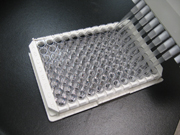The Hepatitis B virus (HBV) causes Hepatitis B, an infection of the liver, and is transmitted through blood or bodily fluids. Markers of HBV infection include the surface antigen (HBsAg), the e antigen (HBeAg), and the core antigen (HBcAg), which are often used for detection.
Our HBsAg ELISA is a sandwich ELISA that is designed for detection and quantitation of Hepatitis B surface antigen in purified virus or unpurified viral supernatant. This assay uses an anti-HBsAg antibody coated plate that binds to any HBsAg present in the sample. A FITC-conjugated anti-HBsAg antibody is then added, which binds to HBsAg sample-antibody complex. This is detected by the addition of an HRP-conjugated anti-FITC antibody. HBsAg levels in unknown samples are calculated based on the HBsAg standard curve.

